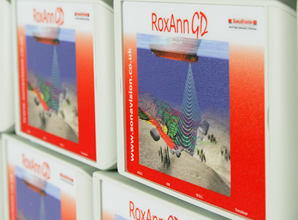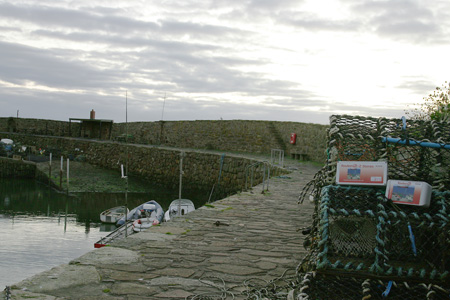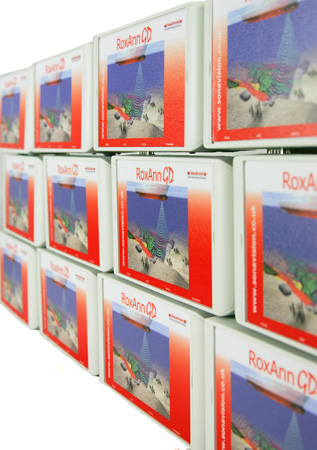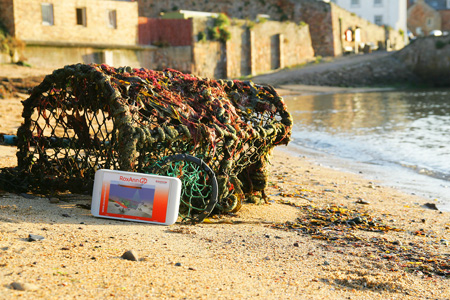IN THIS SECTION
Roxann GD-A Survey and Scientific
RoxAnn GD-A enables the Hydrographer to create colour coded seabed material maps in 2 or 3 dimensions in real time.
The GD-A system interfaces with the existing vessel echosounder and GPS onboard the survey vessel and data is displayed using compatible plotter software running on the survey PC.
It is available for operation with echosounder frequencies from 24 kHz to 210kHz, as a single frequency, dual frequency or four frequency system.
- Easy to Install and Use
- Real Time Data Processing and Display
- Data export to GIS
- Can Be Configured to Operate at up to 4 Frequencies
- Clear User-Defined Numerical Classifications
- Compatible with wide range of echosounders
- Compact - 200 x 110 x 60 mm
RoxAnn has been used for a wide variety of applications over the past decade or more. Here are just a few...
- Fisheries Habitat Studies
- Fisheries Impact Studies
- Marine Archaeological Surveys
- Sediment Monitoring
- Pollution Monitoring and Clean-up
- Coral Studies
- Estuary Management
- Seagrass Condition Monitoring
- Riverbed Civil Engineering
- Environmental Management
- Habitat Restoration Surveys
- Resource Protection and Conservation Surveys
- Marine and Estuarine Ecological Programs Surveys
- Biological Studies
- Geological Studies
- Habitat Mapping
- Remediating
- Hydrographic Surveys
- Natural Resource Assessment
- Shellfish Habitat Mapping
The following are some of the RoxAnn studies by various users world-wide.
An investigation of the relationship between seabed type and benthic and bentho-pelagic biota using acoustic techniques
Siwabessy, Paulus Justiananda Wisatadjaja
Curtin University of Technology, Department of Applied Physics
A growing recognition of the need for effective marine environmental management as a result of the increasing exploitation of marine biological resources has highlighted the need for high speed ecological seabed mapping. More...
Department of Marine Resources, US
The substrate at Webster Head was surveyed with the RoxAnn seabed classification system in May 1998 and with a 1-meter beam trawl in August, September, October 1997 and April, July and August 1998. More...
Seafloor, US
The California Marine Habitat Task Force includes representatives from agencies and institutions with a vested interest in mapping the habitats of the California continental shelf. More...
Marine and Coastal Management - Dealing With the Past - Mapping and cleaning up 40 years of cast-offs at McMurdo Station
By C. K. Bretz, P.J. Iampietro, R.G. Kuitek
The United States established its first year-round research base in Antarctica in 1956 to provide logistical and operational support for polar science activities as part of the International Geophysical Year (IGY, 1957-58). Over the years, the Naval Air Facility McMurdo (renamed McMurdo Station in 1961) has grown from a few dozen prefabricated buildings that supported up to 100 men to the present infrastructure which supports a human population ranging from 200 over-winterers to a capacity of 1200 during summer seasons. More...
Purbeck Marine Wildlife Reserve, Dorset
It may seem surprising that until a few years ago we had only a vague idea of what was on the seabed of the Purbeck Marine Wildlife Reserve. What little information we had came from SEASEARCH divers but this only tells us about small patches of seabed (visibility is generally less than 10m underwater, even on a good day). The difficulty comes in trying to work out what is in between. More...
Monitoring and Management of Marine Protected Areas
Richard Bates Sedimentary Systems Research Group, University of St Andrews, Jon Davies, Marine Information Team, Joint Nature Conservation Committee, Bob Foster-Smith, SeaMap Research Group, University of Newcastle-upon-Tyne
Loch Maddy is a candidate Special Area of Conservation under the EC Habitats and Species Directive for its unusual topography and diverse ecology. Scottish Natural Heritage, one of the UK government's conservation agencies, commissioned a geophysical and biological survey of Loch Maddy as part of the UK Marine SACs project. More...
Deep Water Disposal Site
Parametrix Inc. More...
Under the Sea
For further information, contact Kimberly B. Cole, Environmental Scientist, Delaware Coastal Programs, Division of Soil and Water Conservation, Department of Natural Resources and Environmental Control; 89 Kings Highway, Dover, DE 19901; Phone: (302) 739-3451; E-mail: kcole@state.de.us More...
Predicting the distribution of sublittoral benthic biotopes using acoustic remote sensing
Journal of Coastal Conservation Volume: 8 Issue: 1 Pages: 25-33 Authors: Johnston, C., Davison, A.
To implement the European Directive on conservation of natural habitats (92/43/EEC), government conservation agencies, in this case Scottish Natural Heritage (SNH), must identify areas as possible Special Areas of Conservation (pSACs). More...
The use of seabed acoustic classification (RoxAnn) in identifying the distribution of coral structures
Christophe Chevillon, Institut de Recherche pour le Developpement, IRD (French Research Institute for Development) - Formally known as Orstom, New Caledonia. As part of a soft bottom study we used an hydro-acoustic seabed classification system (RoxAnn‚) in the lagoons of New Caledonia and Fiji. During our prospecting surveys, focusing on the nature and distribution of the sediments, we identified pinacles acoustic signature from that of the sediments (muds, sands and gravels).More...
Trawling and Dredging Impact the Seafloor - Identification of benthic disturbance by fishing gear using RoxAnn [sea bed classification system]
Environment Canada's National Water Research Institute (NWRI) conducts research on freshwater contaminated sediments, much of which is focused on designated areas of concern in the Great Lakes and their connecting channels. More...
Trawling and Dredging Impact the Seafloor - Further analysis of the effect of bioturbation by Nephrops norvegicus (L.) on the acoustic return of the RoxAnn seabed discrimination system.
Environment Canada's National Water Research Institute (NWRI) conducts research on freshwater contaminated sediments, much of which is focused on designated areas of concern in the Great Lakes and their connecting channels. More...
Submerged Cultural Resources Unit (known as SCRU)
National Park Service, Biscayne National Park, USA
Biscayne National Park is the largest marine park in the National Park System, with 95% of its 173,000 acres covered by water.More...
Non-Energy Resources, Connecticut Coastal Waters, Year 9 and 10 Activities
Lewis R. S.; Digiacomo-Cohen M. L.; Neff N.F.; Hyde R. Marine Georesources and Geotechnology The Connecticut effort in year 9 of the Continental Margins Program concentrated on a 13.6-mi2 area south of the Housatonic River. More...
Bottom Classification in the Continental Shelf: A Case Study for the North-west and South-east Shelf of Australia
P. Justy W. Siwabessy, John D. Penrose, David R. Fox and Rudy J. Kloser Centre for Marine Science and Technology, Curtin University of Technology Australia; CSIRO Division, Mathematics Science, Tasmania; CSIRO Marine Research, Tasmania
Bottom classification has been conducted in the north-west and south-east continental shelf of Australia as a part of a CSIRO management program in those areas. More...
Sensitivity mapping of the coastal marine environment in the southern Irish sea. More…
Mapping and monitoring contaminated-sediment geometry and stability
Rukavina N., National Water Research Institute, Environment Canada
Environment Canada's National Water Research Institute (NWRI) conducts research on freshwater contaminated sediments, much of which is focused on designated areas of concern in the Great Lakes and their connecting channels. More...
Acoustic Mapping of Shellfish Habitats.
Study was supported by the European Union DGXIV Fisheries Programme. This paper was presented at ERIM, San Diego, 1999. More...
If you'd like to have details of your RoxAnn study added here, please e-mail us at info@sonavision.co.uk. We look forward to hearing from you!





